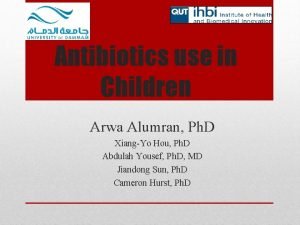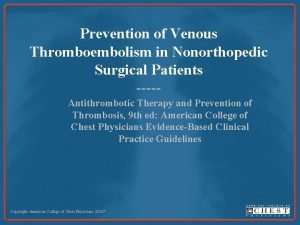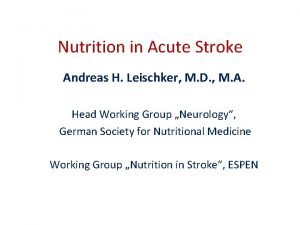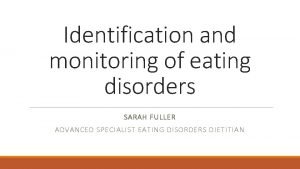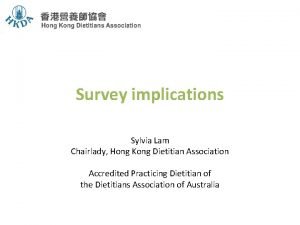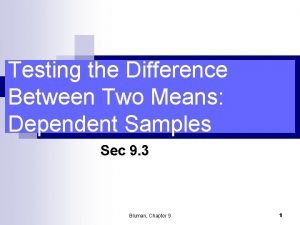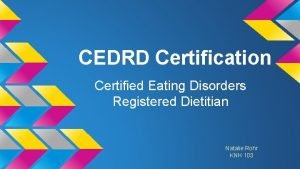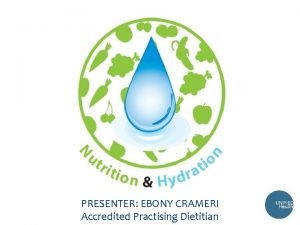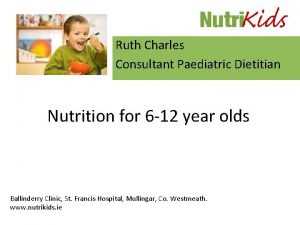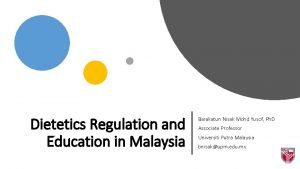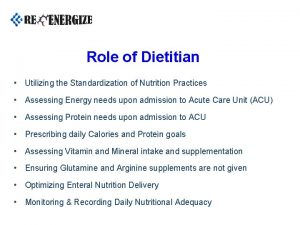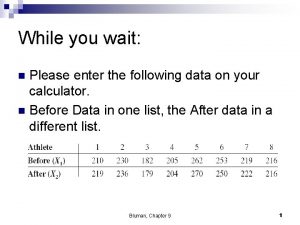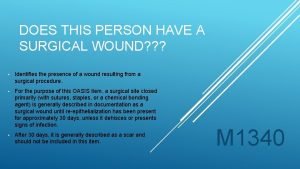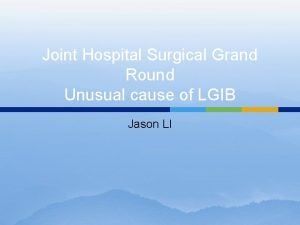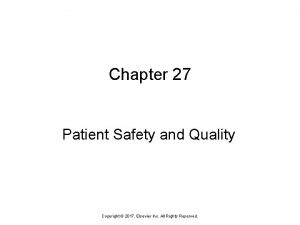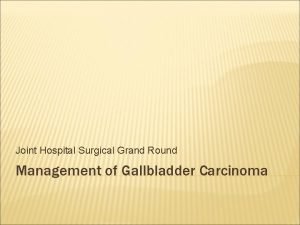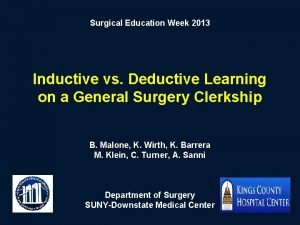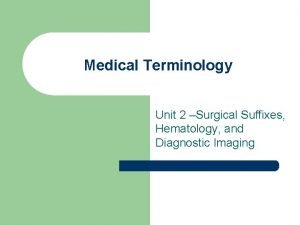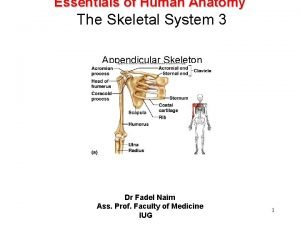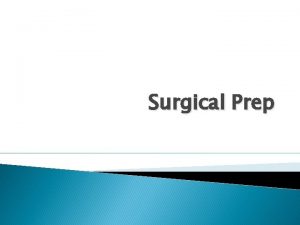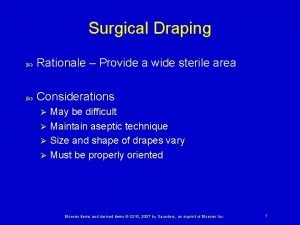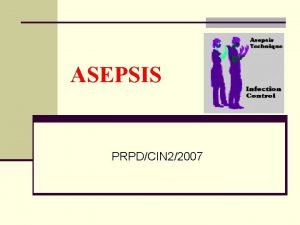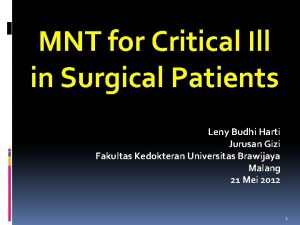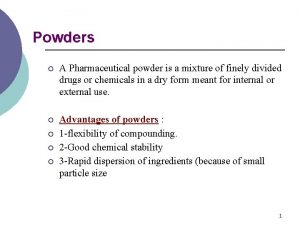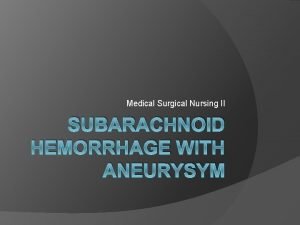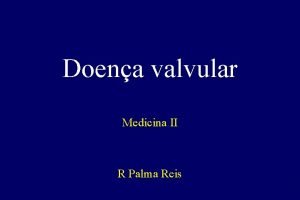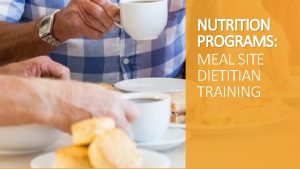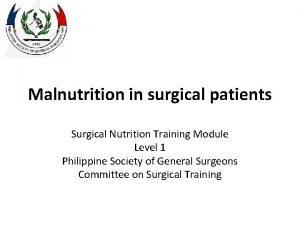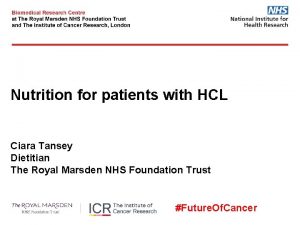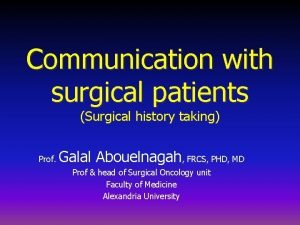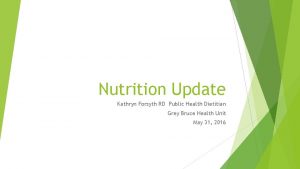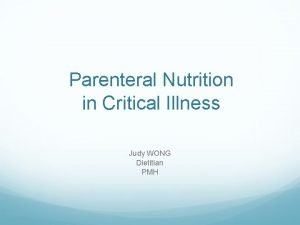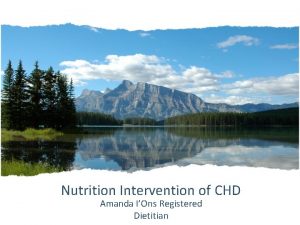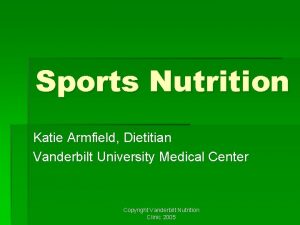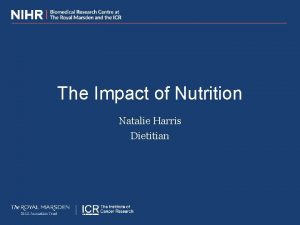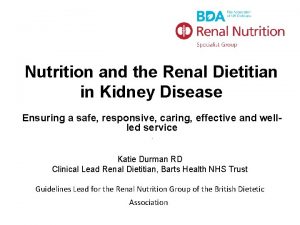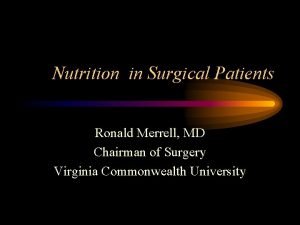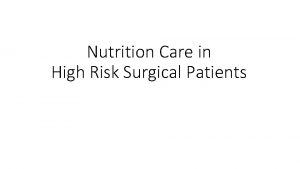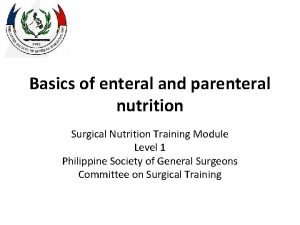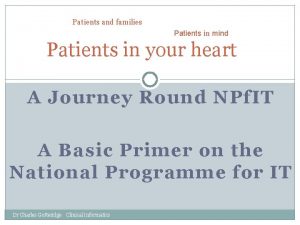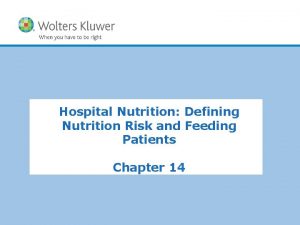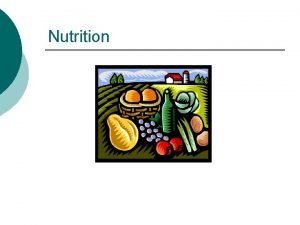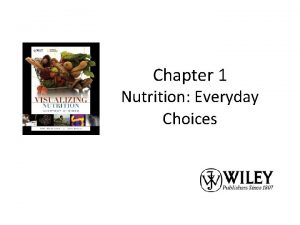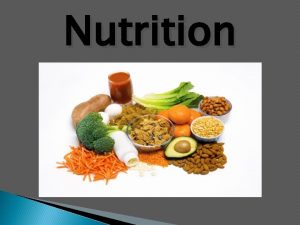Nutrition in surgical patients Dietitian Arwa Al Ajaji
































- Slides: 32

Nutrition in surgical patients Dietitian: Arwa Al. Ajaji

Topic summary üNutrition therapy and nutrition support üWho needs for nutrition support üMalnutrition in surgical patient üNutrition status assessment during admission üNutrition requirements üAdministration of nutrition support üNutrition supplements üWho needs for diet modifications

Nutrition therapy is the provision of nutrition or nutrients either orally (regular diet, therapeutic diet, e. g. fortified food, oral nutritional supplements) or via enteral nutrition (EN) or parenteral nutrition (PN) to maintain optimum nutrition, or to prevent or treat malnutrition

NUTRITION SUPPORT Nutrition Support Therapy is part of Nutrition Therapy. Involves the provision of nutrition beyond that provided by normal food intake using oral supplementation, or enteral tube feeding and parenteral nutrition.

WHO NEEDS Ø Patient at Nutrition risk/or Malnutrished ØPostoperative complications: - Ileus more than 4 days - Sepsis - Fistula formation - Massive bowel resection ØIntractable vomiting; OTHER CONDITIONS : ØMaxillofacial trauma ØTraumatic coma / multiple trauma; ØBurns;

MALNUTRITON ØMalnutrition is a broad term that can be used to describe any imbalance in nutrition; from over-nutrition to under-nutrition. ØObserved up to 40 -60% of surgical patient on admission/remines under -diagnose in 70% of patient in hospital settings. Ømalnutrition seen in hospitalized patients is often a combination of cachexia (disease-related) and malnutrition (inadequate consumption of nutrients) as opposed to malnutrition alone. ØCachexia can be defined as a “multifactorial syndrome characterized by severe body weight, fat and muscle loss and increased protein catabolism due to underlying disease.

Caused by : - Reduced oral intake (fasting, pain on swallowing, physical and mental impairment) - Malabsorption: (Excessive loss from gut, GI Carcinoma, short gut) - Altered metabolism : Trauma, burns, sepsis, surgery.

How to detect patient at risk Nutritional risk screening in all patients on hospital admission or first contact: v BMI <18 kg/m 2 v Combined: weight loss >10% or >5% over 3 months and reduced BMI or a low fat free mass index (FFMI) v Preoperative serum albumin < 30 g/l (with no evidence of hepatic or renal dysfunction)

General Assessment of Nutritional Status History: Weight change Dietary intake change GI symptoms Functional capacity Underlying disease (+ metabolic demand) Physical Examination: loss of subcutaneous fat Muscle wasting Ankle edema sacral edema ascites

LABORATORY MEASURES Øserum proteins such as albumin and prealbumin Øretinol-binding protein (RBP), Ø transferrin, ØNitrogen balance Øtotal cholesterol Øindicators of inflammation such as C-reactive protein (CRP) and total lymphocyte count (TLC),


malnutrition adverse effects §Impaired wound healing §Impaired Immune function and increase risk for infection §Thoracic muscle mass wasting depresses respiratory efficiency and increase risk for pneumonia §Albumin level decrease leading to generalized edema. §Small bowel mucosa atrophy §Impired mental function leads to depression §Post operative complications rate is higher §Prolong recovery time and longer hospital stay

When start

Enhanced recovery of patients after surgery (‘‘ERAS’’) has become an important focus of perioperative management. From a metabolic and nutritional point of view, the key aspects of perioperative care include: ØAvoidance of long periods of pre-operative fasting ØRe-establishment of oral feeding as early as possible after surgery Ø Integration of nutrition into the overall management of the patient metabolic control, e. g. of blood glucose; ØReduction of factors which exacerbate stress-related catabolism or impair gastrointestinal function; ØEarly mobilization

PRIOPERATIVE • Patients with severe nutritional risk shall receive nutritional therapy prior to major surgery, appropriate period of (7 -14 )days • Fasting from midnight is unnecessary in most patients - ALLOW clear fluids until two hours before anaesthesia - (clear fluids empties the stomach within 60 -90 min) POST OPERATIVE Oral intake, including clear liquids, can be initiated within hours after surgery in most patients. Early normal food or EN, including clear liquids on the first or second postoperative day, does not cause impairment of healing of anastomoses in the colon or rectum Early tube feeding (within 24 h) shall be initiated in patients in whom early oral nutrition cannot be started, and in whom oral intake will be inadequate (patients undergoing major head and neck or gastrointestinal surgery for cancer , severe trauma, including brain injury, patients with obvious malnutrition at the time of surgery )

Modes of administration What Route should be used EN vs PN

Enteral Nutrition Enteral nutrition (EN) by means of oral nutritional supplements (ONS) and if necessary tube feeding (TF) The enteral feeding should always be preferred over Parenteral Nutrition

Enteral Tube feeding Indications: Contraindications: ØMalnourished patient expected to be unable to eat adequately for > 5 -7 days ØIntestinal obstructions or ileus, ØAdequately nourished patient expected to be unable to eat > 7 -9 days ØIntestinal ischemia ØAdaptive phase of short bowel syndrome ØFollowing severe trauma or burns ØEarly oral nutrition cannot be started, (patients undergoing major head and neck or gastrointestinal surgery for cancer , severe trauma, including brain injury, patients with obvious malnutrition at the time of surgery ) ØSevere shock Ø High output fistula ØSevere GI bleed ØSever acute pancreatitis

Parenteral nutrition For the surgical patient PN is beneficial in the following ; ØUndernourished patients in which EN is not feasible or not tolerated Ø Patients with postoperative complications impairing gastrointestinal function who are unable to receive and absorb adequate amounts of oral/ enteral feeding for 5 -7 days PN should only be initiated if the duration of therapy is anticipated to be >7 days. Øprovision of PN of 25 kcal/kg and 1. 5 g/kg protein presented no increased risk of hyperglycaemia and infectious complications ØIN some cases, Combined EN/PN showed clinical benefits when compared with EN or PN alone, NOT necessary if expected time period for PN <4 days

Assess nutrition needs

Energy and protein needs Stable Non-ICU patients BMI (kg/m 2) Weight (kg) Kcal/kg < 30 ≥ 30 Actual Adjusted 25 -30 20 -25 Protein* (gm/kg) 1. 2 -1. 5 Ideal body weight: (Male): 50 + 2. 3 (height in inches - 60); (Female): 45. 5 + 2. 3 (height in inches - 60) Adjusted body weight: IBW + [(actual weight – IBW) x 25%] ICU patients BMI (kg/m 2) Weight (kg) Kcal/kg < 30 30 -50 > 50 Actual Ideal 20 -25 11 -14 22 -25 Protein* (gm/kg) 1. 2 -2. 0 1. 9 -2. 0 (IBW) 2. 5 (IBW)

Fluids needs Age (years) ml/kg 18 -65 65+ Hemodialysis 30 -35 25 -30 1000 + output Reference: http: health. qld. gov. au/masters/copyright. asp NOTE: Fluid needs should be determined by evaluating the patient’s clinical condition Decreased fluid needs (20 -25 ml/kg actual BW): renal failure, dialysis, edema, CHF. Increased Fluid needs (30 -35 ml/kg actual BW): short gut syndrome, high output ileostomy or fistula, excessive diarrhea, high NGT output, large draining wounds, chest tube and JP drain losses.

Calculating Fluid Needs for Obese (BMI ≥ 30) Adjusted Weight Fluid per day 40 -60 kg 60 -80 kg > 80 kg 1500 - 2000 ml 2000 - 2500 ml 2500 - 3000 ml OR 30 -35 ml/kg Adjusted body weight with allowances for extra losses via drains (draining wounds, chest tube and JP drain losses) Reference: http: health. qld. gov. au/masters/copyright. asp

Immunonutrition involves the administration of nutrients via enteral or parenteral routes in supranormal amounts, to achieve a pharmacological effect on one or more components of the patient’s response to surgery, trauma or infection. ØIn the preoperative phase, formulas enriched with arginine, omega-3 fatty acids and nucleotides have been shown to improve postoperative immune response, gut oxygenation and intestinal microperfusion

Glutamine: Glutamine is essential amino acid and the preferred fuel for rapidly replicating cells such as gastrointestinal mucosal cells (enterocytes and colonocytes) and immune cells (lymphocytes and macrophages) ØFurther prospective, randomized trials are necessary to recommend widespread utilization of glutamine in nutritional support Arginine : L-arginine, a dibasic amino acid, has numerous important roles in the transport, storage, and excretion of nitrogen; formation of nitric oxide; mediation of macrophage function after injury; and regulation of wound healing ØAntioxidants, including vitamins C and E, betacarotene, and selenium are often added in an effort to reduce oxidative stress among patients with acute metabolic stress.

The European Society for Clinical Nutrition and Metabolism (ESPEN) has established guidelines for use of enteral nutrition that included a consideration of “immunonutrient”. Use enteral nutrition with immuno-modulating substrates (arginine, nucleotides and long-chain n-3 fatty acids) perioperatively in: Ø patients undergoing major neck surgery for cancer Ø patients undergoing major abdominal surgery for cancer. ØMajer upper GI surgery ØElective upper gastrointestinal surgical patients ØPatients with mild sepsis/AVOID in sever sepsis ØPatients with trauma ØPatients with acute respiratory distress syndrome ØAvoid Immune Enhancing formulas in actively septic patients. ØNo recommendation for immune-modulating formulae can be given in burned patients due to insufficient data. ØICU patients with very severe illness who do not tolerate more than 700 ml enteral formula per day should not receive an immunemodulating formula

Select Formula

Standard 1 kcal/1 ml Ensure Nutren 1. 0 Osmolite RTF Energy zip 1. 0 Jevity Trophic with fiber Standard formula can be used via ENETRAL FEEDING OR orally - Can be used for all cases Dens-calories 1. 5 g/ml Ensure Plus Fortisip Resource Plus Ensure Two-Cal for stressed patients and those requiring low-volume feedings Modified carbohydrate Glucerna 1 kcal/1 ml Resource Diabetic Diamax Diabetes Mellitus, Hyperglycemia, Glucose Intolerance Low elctrolyets 1. 5 -2 kcal/1 ml Dialysis / Renal Failure / Renal Disease, Electrolyte and Fluid restriction Novasource Renal HD Max

Branched-Chain Amino Nutrihep Acid 1. 5 kcal/1 ml Hepatic Encephalopathy, Nutrition support for hepatic disease with elevated ammonia level Low carbohydrate 1. 5 kcal/ml Oxepa Pulmocare modulate the inflammatory response in critically ill, mechanically ventilated patients, especially those with SIRS (systemic inflammatory response syndrome, eg, sepsis, trauma, burns), ALI (acute lung injury) or ARDS (acute respiratory distress syndrome) Nutrient Dense/ Immunonutrients 1. 2 -1. 6 kcal/ml IMPACT RECOVERY For faster recovery ( before and after surgery), Severe trauma/injury, support colonic health, Pressure ulcer/wound, Dietary mgt of Cachexia in cancer , pancreatic cancer, lung cancer undergoing chemotherapy Clear Liquids with Protein/ Fat-Free 1. 5 kcal/ml Resource Breeze Fortijuice FORTICARE Clear Liquid High Protein, bowel prep, fat malabsorptive/fat restricted, pre or postsurgical , nausea/vomiting/oncology

Semi-Elemental Perative 1. 3 Malabsorption syndrome, impaired Pivot 1. 5 gastrointestinal function, short bowel Peptamen Complete syndrome, inflammatory bowel disease, Alitraq pancreatic insufficiency, chronic diarrhea, radiation enteritis, HIV/AIDS-related malabsorption, transition diet from TPN Protein 6 g per scoop Beneprotein Prosource Protein-calorie malnutrition, wound healing e. g. burns, pressure ulcers Prebiotics Banatrol Diarrhea and loose stool associated with tube feeding, antibiotics , oncology treatment and Clostridium difficile

Need Diet modifications ? ?

https: //pdfs. semanticscholar. org/ee 63/9712 fd 34 f 3 ff 5 ea 80 c 6 b 65927 c 6 5 cd 63 aaa 6. pdf http: //extranet. hospitalcruces. com/doc/adjuntos/ENSurgery. pdf https: //med. virginia. edu/ginutrition/wpcontent/uploads/sites/199/2014/06/Parrish-August-16. pdf http: //www. espen. org/files/ESPEN-guideline_Clinical-nutrition-insurgery. pdf
 Arwa-028
Arwa-028 Prevention of vte in nonorthopedic surgical patients
Prevention of vte in nonorthopedic surgical patients Guideline clinical nutrition in patients with stroke
Guideline clinical nutrition in patients with stroke Sarah fuller dietitian
Sarah fuller dietitian Sylvia lam
Sylvia lam A dietitian wishes to see if a person's cholesterol
A dietitian wishes to see if a person's cholesterol Eating disorder dietitian certification
Eating disorder dietitian certification Ebony crameri dietitian
Ebony crameri dietitian Ruth charles dietitian
Ruth charles dietitian Adjusted body weight formula
Adjusted body weight formula Barakatun nisak
Barakatun nisak The role of dietitian
The role of dietitian A dietitian wishes to see if a person's cholesterol
A dietitian wishes to see if a person's cholesterol Picc line surgical wound oasis
Picc line surgical wound oasis Wellspan surgical and rehab hospital
Wellspan surgical and rehab hospital Esophgeal varices
Esophgeal varices Broad based protrusion
Broad based protrusion Chapter 27 patient safety and quality
Chapter 27 patient safety and quality Joint hospital surgical grand round
Joint hospital surgical grand round Surgical metabolism
Surgical metabolism Inductive vs deductive learning
Inductive vs deductive learning Ogden surgical medical society
Ogden surgical medical society Ectomy medical term
Ectomy medical term Surgical neck
Surgical neck Surgical prep guidelines
Surgical prep guidelines Kimberly clark surgical drapes
Kimberly clark surgical drapes Asepsis
Asepsis Surgical metabolism
Surgical metabolism Define powder in pharmaceutics
Define powder in pharmaceutics Aneurysym
Aneurysym Cmr surgical
Cmr surgical Incisión rutherford morrison definicion
Incisión rutherford morrison definicion Hematology suffix
Hematology suffix
